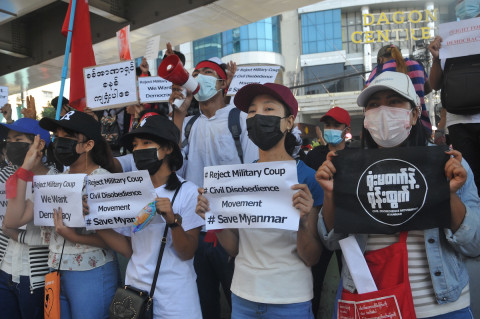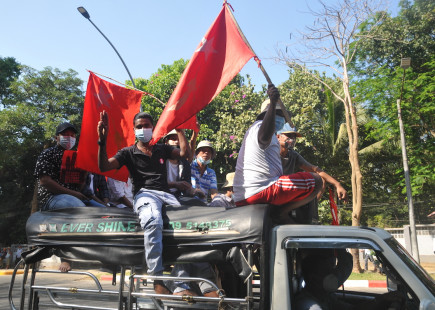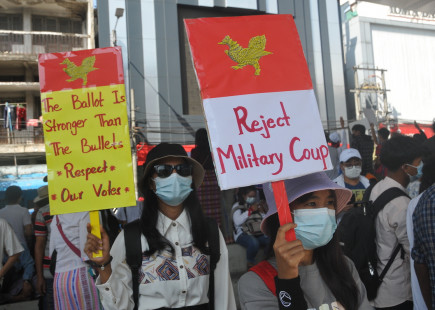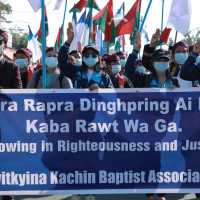History repeated: Another roadblock to political change in Myanmar
Regions
Today is Union Day in Myanmar, which marks the historic Panglong Agreement in February 1947 when the principles of equality and unity were drawn up for the future union. In 2021, however, it is not a day of celebration but one of protest as peoples across the country take to the street to demonstrate against the assumption of power by the military State Administrative Council. In this commentary, TNI analyses why the present crisis is so profound and why the patterns of military rule, state failure and ethnic conflict are in grave danger of being repeated. Peace and national reconciliation are required today, not at some indeterminate time in the future.

The prospects for peace and democratic transition in Myanmar are at a perilous stage. Since independence in 1948, the country has been entrapped in a cycle of conflict, state failure and political impasse in which the aspirations of the people for democratic rights and political freedoms have consistently been denied. Whether under elected or military administrations, ethnic conflict and political violence have continued through all governmental eras, perpetuating loss of life and immeasurable suffering in communities across the country. All the peoples have suffered, and threats to livelihoods and security have been especially pronounced during times of intra-governmental rivalry and change. This must not happen again.
The post-colonial experiences of Myanmar (formerly Burma) provide stark warning. Roadblocks have been put in the way of democratic reform with systematic regularity in every field of national life. There have been five general elections since 1960, and the latest military interdiction is the third time that such an obstacle has been imposed by the Myanmar armed forces (Tatmadaw). Through such interruptions, the shadow of military rule has continued. In the footsteps of Gens. Ne Win and Than Shwe, a new military strongman, Snr-Gen. Min Aung Hlaing, has now taken on the figurehead role as head of state.
The evidence of military interference in democratic process is overwhelming. The 1960 general election was followed by the 1962 coup d’etat and arrest of Prime Minister U Nu and other political leaders. The results of the 1990 general election were never implemented, and MPs-elect of the National League for Democracy and ethnic nationality parties were arrested when they sought to call a parliament. And now, on the basis of challenging the conduct of the 2020 polls, another military regime – the State Administrative Council – has assumed power, arresting NLD leaders who were in partnership with Tatmadaw officers in government until just two weeks ago.
From this dysfunction, instability radiates out from the political centre of Nay Pyi Taw to other parts of the country. Military rule is the manifestation of a weak state – not a strong state. Following the conflict-driven patterns in post-colonial politics, the shifting contestations for national control are creating a landscape of new divisions in one of the most ethnically-diverse lands in Asia. Tragically, political promise followed by ethno-political breakdown has followed every change of government since independence in 1948.
In 2021, history is repeating itself. The latest coup is bringing to the surface two underlying schisms in national politics. The first is between the two main parties among the ethnic Bamar (Burman) majority – in this case the NLD and the Tatmadaw, the latter of which is backed by the Union Solidarity and Development Party. And, leading on from this, the ruptures and changes in inter-relationships between the two main parties in central Myanmar threaten to set off a second, and in many ways more complex, fracturing among non-Bamar peoples who constitute an estimated third of the 54 million population and inhabit all the country’s borderlands.*
This has happened many times before, most obviously in 1948, 1962, 1988 and 2011. As in every political cycle, ethnic nationality movements are faced with a precarious choice: which party among the Bamar majority population should they seek to support or work with in order to bring about peace and meaningful political change? Such a portentous moment of decision-making exists again today.
History demonstrates that there are no easy answers. In a divided landscape, not only is the Bamar population disunited but ethnic parties have long learned that accommodation with one national party inevitably brings marginalisation or hostility from its main rival in the struggle for control of the central government. These partitions and divisions over choices have continued through all political eras since independence.

The cycles of reform impasse are unbroken. Contestation for the control of government has passed from the Anti-Fascist People’s Freedom League and Communist Party of Burma in 1948 to the military-backed Burma Socialist Programme Party in the 1960s to the Tatmadaw-NLD competition that has continued since 1988. But, along the way, there have been no moments of nationwide peace and dialogue inclusion. Rather, the failures of the central state are reflected in political deadlock, labyrinthine alignments and unaddressed conflicts that still continue in the ethnic states today.
To understand the contemporary landscape is to understand the unaddressed legacies from the past. Many of the current difficulties emanate from the era of the military State Law and Order Restoration Council (subsequently State Peace and Development Council), which assumed power in September 1988 after suppressing democracy protests that brought down the “Burmese Way to Socialism” of Gen. Ne Win.
To give just one example, following the SLORC takeover, the armed Karen National Union (established 1947) maintained advocacy and support for the NLD-led movement for democracy, suffering Tatmadaw offensives into its administered areas along the Thailand border during the following two decades. In contrast, the armed Kachin Independence Organisation (established 1961) agreed a 1994 ceasefire with the SLORC government in the Chinese borderlands on the basis that it is better to negotiate with officials among the ethnic Bamar majority who actually have power. In Myanmar’s highly-militarised politics, the ceasefires of the SLORC-SPDC era were essentially agreements between military leaders on the different sides.
Come 2011, however, this strategic balance was completely upturned when the KIO ceasefire was broken by the incoming administration of President Thein Sein, who had been prime minister in the former SPDC. By contrast, the KNU agreed a ceasefire – its first of any duration since 1949 – in a newly-conceived process that promised to bring nationwide peace to the country. In essence, with the change in government, the Tatmadaw reversed its strategic focus between the southeast and northeast of the country. Politics per se did not come into these calculations.
A decade later, it has to be questioned whether peace or democracy have been meaningfully advanced by either Kachin or Karen parties in the contrasting decisions that they took in the different eras of government. Whether under the Tatmadaw or USDP and NLD-led administrations, both the Kachin and Karen States – like many other nationality lands – have remained de facto conflict zones, with the swing in the political pendulum largely determined by actors in the corridors of power in Nay Pyi Taw. Large populations of refugees and displaced civilians continue to live in both the Chinese and Thai borderlands, and agreement on political reform looks no closer to inception.
It is little wonder, then, that ethnic parties remain highly cautious today. After a decade in fragile co-existence, the country’s military leaders have moved decisively against the NLD, disrupting political relationships and reform pathways that had slowly built after the party entered parliament in 2012 by-elections. Indeed since the 2020 elections, though claiming continuity, the Tatmadaw leadership have recharged their political ambitions and strategic intentions with a profundity that, for the moment, bears comparison with the tumultuous years of 1962-64 and 1988-90. Amidst the excitement of the November elections and crisis of COVID-19, communities in every state and region have been wrong-footed, hence the scale of current protest and outrage. As all sides know, such actions can come to define national politics for the next generation.
A highly dangerous moment has arrived. The Tatmadaw’s attempt to reset the narrative in governmental change has triggered a much more radical reaction across the country. The uncertainties and cyclical patterns in Tatmadaw realignments are not only reflected in the suppression of the NLD and pro-democracy protests in urban areas. They are also evident in a new – and still unfolding – reconfiguration of military relationships and security policies in the ethnic states and conflict zones.
Every part of the country is currently affected. During the past two months, Tatmadaw incursions have intensified in KNU-administered territories in northern Karen State, where a ceasefire has been in place since 2012. In contrast, Tatmadaw commanders have reached out to the United-League for Arakan-Army Army and electoral Arakan National Party after two years of ceasefire exclusion and political marginalisation in Rakhine State. Fighting and civilian displacement have been resurging in one part of the country while apparently declining in another. Equally dissonant, while NLD leaders are being arrested, Rakhine political prisoners are being released.
As with the move against the NLD, this looks an apparent volte-face that had not seemed possible before the general election. But with the new State Administrative Council pre-occupied with urban control as it promises fresh elections a year from now, more such peace gestures towards ethnic-based movements are deemed likely as the country’s military leaders seek governmental legitimacy. Following the patterns of the past, all incoming governments roll out new peace initiatives to mark their advent to office.
Whether, however, the SAC junta is truly opening up new avenues to peace is far from certain. In the conflict zones, respite from fighting is always welcomed among long-suffering communities. But, in 2021, the situation is very different. The most popular party in the country, the NLD, been shut out by the Tatmadaw. At the same time, as among young Bamar people, a new generation of ethnic activists has come to the fore who are far more demanding for change, and they are unwilling to return to the “neither war nor peace” paradigms of the past.
In many ethnic areas, the humanitarian situation is now critical after decades of unending warfare. There are over two million people displaced from their homes, either internally or who are living as refugees in neighbouring countries. COVID-19 is also standing in the background. But, to date, little start has been made in addressing the causes of conflict, and the current turmoil for control of government may only worsen the plight of the most vulnerable peoples. Bamar, Chin, Kachin, Karen, Karenni, Mon, Rakhine, Rohingya, Shan, Ta’ang and other nationalities – all the peoples of Myanmar have been grievously afflicted by the political failures and unresolved conflicts during the strife-torn years since independence.
Looking to the future, it thus has to be asked whether there is truly any political endgame in sight. After nearly six decades of Tatmadaw-dominated government, the latest incarnation of military rule, the State Administrative Council, has promised to be different to other regimes and has selectively invited other (non-NLD) parties and political representatives to join them. The question, though, is whether any political actor in the country can confidently engage with this prospect. To agree or not to agree is indeed the burning question.
For the moment, parliamentary processes have been brought to an end. This leaves only the ethnic peace process, which began in 1989 under the former SLORC-SPDC government, as a potential route for dialogue. But engaging with the peace process is a very difficult proposition. Recalibrated by the Thein Sein government, the current peace process is one of the most complicated – if not the most complicated – in the modern world. In addition to unilateral ceasefires, bilateral ceasefires and a 2015 Nationwide Ceasefire Agreement with less than half the ethnic armed organisations in the country, there is also a 21st Century Panglong Conference and the now suspended legislatures for parliamentary reform that have yet to be brought onto the same track. To date, Tatmadaw leaders have refused to countenance any changes to the military-drafted 2008 constitution.
Confusingly, too, one of the first acts of the new SAC was to disband the National Reconciliation and Peace Centre, which was previously leading the peace process on the NLD-led government side. Its leaders, Daw Aung San Suu Kyi and Dr Tin Myo Win, have been arrested and, instead, the SAC has said that negotiations will in the future be led by the Tatmadaw’s own Peace Talks Committee. In the meantime, the Nationwide Ceasefire Agreement will remain in place, and all ethnic armed organisations are being urged to sign.
The response, though, of ethnic leaders is presently uncertain. Those who have engaged in the NCA process with the USDP and NLD-led governments are questioning the value of their commitment, while those who have not signed the NCA – both ceasefire and non-ceasefire groups – are closely watching every move in the national landscape. A deepening clampdown on democracy supporters, and certainly the use of force by the security services, will likely reinforce their determination to persist in their demand for a process of meaningful political change whoever is in control of the government. The demands and courage of young people, activists and the general public participating in the civil disobedience movement have attracted widespread sympathy in every sector of society.
Equally important, after another decade of failed endeavours to achieve peace and reform, a new frustration is apparent in nationality circles. Even before the present coup, many parties were beginning to question whether there is any ultimate destination for Tatmadaw leaders other than continued dominance over political life. All sides have already agreed upon the general goals of federalism and democracy, but there has been no further reform progress. As such, the complex web of ceasefire procedures that have developed during the past decade appear more as mechanisms to establish centralised control rather than processes to negotiate and implement political reforms. Leaders of nationality movements are increasingly voicing their frustrations. As alignments continue to shift in Myanmar politics in the wake of the SAC coup, hopes of national peace and inclusion are disappearing once again.
Finally, the question needs to be asked is whether anything can be done today to stop another repetition of the debilitating cycles of political impasse and state failure from the past. The answer must be yes for there was nothing preordained at the independence of Myanmar, a land of great human and natural resource potential, to suggest that the conditions of such enduring conflict and political breakdown would follow. But first the lessons from the past must be learned and enacted upon.
Top of any list must be an immediate halt to military coercion and political violence. Conflict will never resolve challenges that are political are root. No side has a monopoly on political righteousness. Those who hold guns need to recognise that armed struggle has not achieved political goals, while politicians in the legislatures should acknowledge that they have also failed to bring about long-urgent reforms. For a genuine and lasting peace, all sides have to face up to their responsibilities towards the human rights and well-being of all the peoples of the country.

Following on from this, it needs to be recognised that every time the processes of political reform are interrupted by military interdiction, this only compounds the challenges of achieving national peace and reconciliation. The grievances and aspirations of the different peoples can only be addressed by open and inclusive dialogue. In 1962, Ne Win’s military coup stopped parliamentary discussion of the Federal Proposal among political parties. The 1990 clampdown prevented the NLD and other elected parties setting up democratic procedures to draw up a new constitution. And the present military interregnum under Snr-Gen. Min Aung Hlaing has stopped elected representatives from taking office under a constitution that the Tatmadaw itself devised. All these events mark moments of lost – not gained – opportunity.
In 2021, communities across the country are very confused but united in their condemnation of the coup that has taken place. Equally serious, a decade of ethnic peace talks have been disrupted at a critical moment, with none of the negotiating parties certain in which political direction the country is now heading. Rather, in their explanations so far, the Tatmadaw leadership have decided to change strategic course in both their “parliamentary” and “peace talk” actions for reasons that appear more technical about procedure than concrete on political grounds. As in 1962 and 1988, a large political vacuum currently exists.
For these reasons, the coming months are very hard to predict. But, if the country is to step back from a new cycle of conflict and political stasis, there is only one way to proceed. For peace and national reconciliation to take root, the politics of exclusion and marginalisation must be brought to an end, and a framework for peace and political representation must be established that, this time, allows all parties, demands and voices to be heard and acted upon.
This, in essence, was what the National Convention of the SLORC-SPDC era and the 21st Century Panglong Conference of the NLD era were both supposed to achieve. Neither crossed the inclusion threshold nor allowed genuine discussions to take place. Nevertheless both provide precedents for new pathways to peace in which new visions of Myanmar’s political future can be refashioned to reflect its vibrant and multi-ethnic character.
And this is where there are still grounds for optimism. During the past decade, the hopes and determination for peace and reform have been ever more vocally expressed, whether through parliamentary parties, the ethnic peace process or the grassroots energies of civil society groups. These are the only ways forward and their momentum must be maintained. In 1988, a generation of young people stood up to demand freedom and fundamental human rights. In 2021, history is repeating itself. In the digital age, the whole world is watching. In Myanmar, there is support among all peoples and groupings in society for the common goals of liberty and democracy. It is the time for change and vital that another young generation is not lost.
* “Borderlands” can be a subjective term, interpreted as implying a secondary or peripheral status. In this commentary, the term is used in geographic relation to other territories or countries.
